#in the same way bees and ants are matriarchal
Explore tagged Tumblr posts
Text
Rereading a book I haven’t touched in 30 years, that is significantly older than that, and just.
Huh.
I didn’t remember all the misogyny. Which makes sense, because I was teenager then, and also it’s a sci-fi book from the 80s, but still.
Also didn’t remember the sentient dinosaur nonconning her captive 15 year old boy.
#anyway yeah#kelly reads things#west of Eden#harry harrison#the dinosaurs are pretty awful#and matriarchal#in the same way bees and ants are matriarchal#and they genetically engineered animals to do everything#like they have gun animals#and microscope animals#and camera animals#and printer animals#and GIANT SUBMARINE TRANSPORT animals#and the humans are Stone Age bros#who feel an intense need to murder the dinosaurs whenever they see them#like the whole conflict is kicked off because they saw a dinodaddy on a beach#and slaughtered him when he was just trying to hatch his eggs#but really#it’s the matriarchal dinosaurs who are bad#should’ve just reread stainless steel rat instead
2 notes
·
View notes
Text
Social Spiders: A Ramble
HELLO FRIENDS!
@nurgletwh was wondering about if there are any 'social spiders', and I decided to write here instead of spamming it on AO3.
Firstly, lets define the difference between 'social' and 'communal', as both exist and can be used to describe various species of invertebrates.
Communal means that the organism can exist with other organisms with it's type and generally not have any problems. They don't actively help each other, but are kinda like buddies in the same room. Millipedes and Isopods are examples of communal invertebrates, just hanging out doing invert things.
Social means that the organism exists with other organisms of it's type and have active, defined roles within to benefit the group as a whole. Ants and honey bees are good examples, as everyone actively works to better their colonies/hives. There is active care for each other involved, such as feeding each other, grooming each other, or conveying messages and signals. Think of them like a family. Swarming occurs when the colony gets too large and splits, with the leaving group establishing a new colony elsewhere.
Most spiders are solitary and only pair up when it's time to mate. Many are maternal and will carry/guard their eggs until they hatch, which then they go off on their own when ready. Either by ballooning (letting a thin string of web catch on the wind and carry them away) or by just jumping off mom and going their own way. Point is that slings (baby spiders) don't stick around too long.
Annnd under the cut, we will talk about spiders that DO stick around! Warning! I will be including pictures of spiders under the cut! I hope you will still read if you are able, but don't distress yourself in the process!
NOW, on to SOCIAL SPIDER BUDDIES!
Firstly, lets look at perhaps the best example of a social spider, the Anelosimus eximius. The entire genus of Anelosimus has a sliding scale of social interactions by individual species, which makes it excellent for studying social behavior and how it evolves.
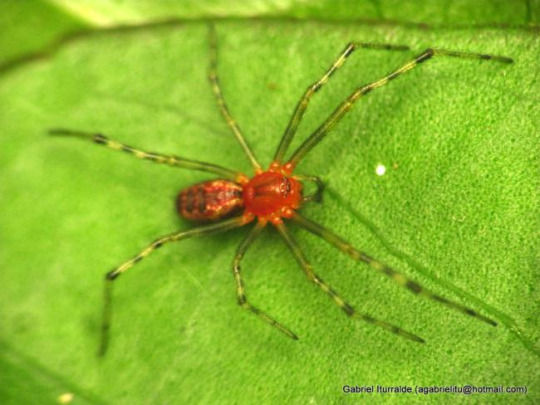
Anelosimus eximius are quite small, and are less than 8 millimeters at the largest size of the spectrum. This is an adult female. Teeny.

Here is a colony all grouped together. You might think, 'oh, this is just a small little nest', but you are WRONG.

Their nests are HUGE (around 25 feet LONG) and can contain more than twenty to fifty thousand individual spiders. (Don't worry friends, this particular species only live in warm tropical areas of central and south America.)
But you ask yourself, why would these spiders choose to work together when they can just fuck off and do their own thing? Well, it's for the same reason we humans lived together in colonies. You would find more similarities between us and them than you can think!
1. Food. By using this wide net, these spiders can catch very large prey, including BATS and BIRDS! Mostly however, they eat larger insects. The colony shares their catches with the rest and allows the injured and sick to share as well. They may not be able to catch big prey very often, but when they do its a influx of nutrients that an individual spider would never even dream of getting!
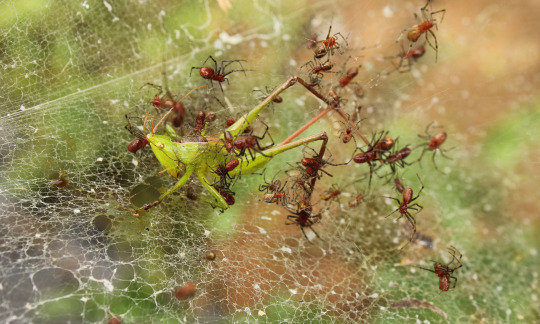
(Anelosimus eximius swarm their prey like a wolf pack!)
2. Reproduction. To keep this species in check, only a few females in the colony will lay eggs at a time. This isn't due to a caste system, since they have none, it's just a way to be sure there is enough food to go around. Since there are less females laying eggs, the entire colony participates in guarding and caring of the eggs and slings. The quality of their young is much higher than those of a solitary spider, who have a lot of babies in hopes that some will make it to adulthood. But with these guys, the babies are cared for and have a much better chance of making it and becoming another member of the colony. A.eximius females even feed the slings like a mother bird does to her chicks!
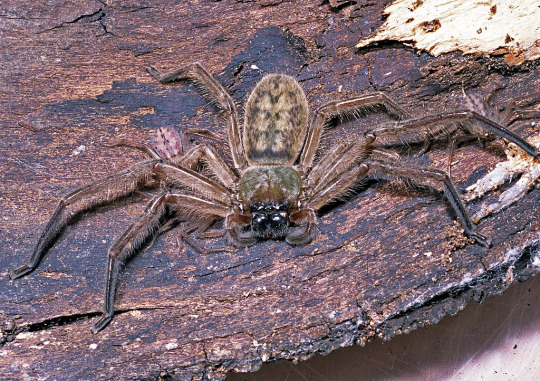
(Delena cancerides live in family groups, headed by the matriarch (mother) spider.)
3. Altriusm. This is a trait where you do something because it is kind with no real reward involved. These spiders have undergone experiments where they have adopted slings from other nests and seem to not really care about where they came from. Some other spiders will do this as well, such as wolf spiders. However, by developing altruistic traits, it helps out the rest of the colony in ways that will keep philosophy majors debating for centuries. Also, with more spiders helping, individual spiders have more time to rest and eat, reducing stress and becoming healthier!

(Theridion nigroannulatum is another social species, and you can see females with their egg sacks being guarded by other members of the colony)
4. Defense. The more individuals are in one place, the better they can defend themselves. These spiders often have to deal with kleptoparasites, other animals that feed themselves by stealing from others. Having more individuals helps them drive away these nuisances and protect their resources.
5. Maintenance. More hands (or spinnerets) means more can get done in a shorter amount of time. Some spiders of the colony will repair webs or lay down new lines. Some will remove mold and parasites and dispose of them. Some will keep the web and other members clean. A rainstorm that destroys the web of a regular spider will take a long time to repair, but for Anelosimus eximius, there's already someone fixing it as soon as it happens. Oddly enough, many members of this species fall into roles they feel are most suitable to them. They are egalitarian!
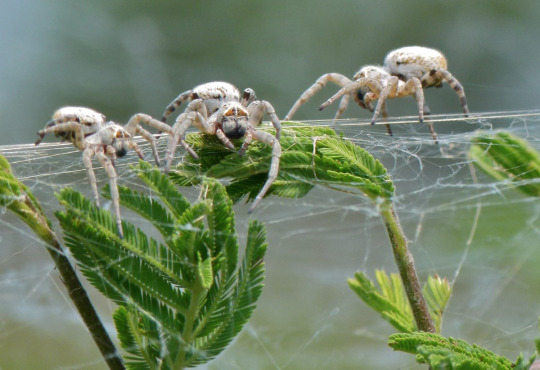
(Stegodyphus dumicola work together to repair the web and keep it clean.)
A great big negative however, is lack of genetic diversity. It is difficult for 'new blood' to enter a colony, because the colonies around said colony are offsets of said colony. Colonies within a specific area tend to be related to each other, so the spiders themselves are essentially clones.
The positives outweigh the negatives in terms of forming a colony, so why don't all spiders do this?
Because different spiders occupy ecological niches and some of those roles don't allow for much socialization. The amount of food needed to feed large colonies is huge and it must have consistent prey. Environment and weather provides a factor too. It takes the right environment, weather, and prey density to allow a species to evolve to band together for mutual benefit. Some species figured out that banding together gets them through rough times and have stuck with the strategy since.
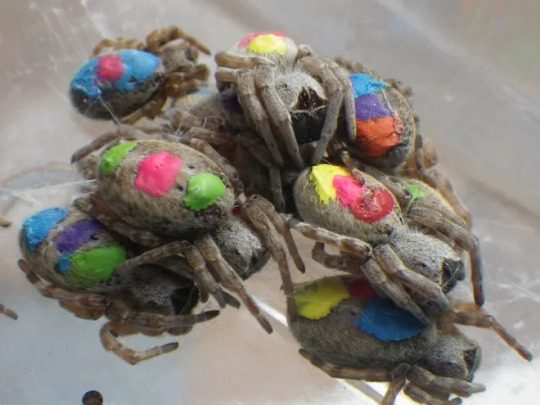
(To study how social spiders divide labor and develop personalities, some poor intern had to catch a bunch of Stegodyphus sarasinorum and put paint on their butts.)
There are only about 23-27 confirmed (some debated) species of social spider (that we know of here in Aug 2021), which is quite small compared to the large number of other kinds of spiders! There are over forty thousand species of spiders currently recorded as of Aug 2021, so that means that social spiders only make up around 0.06% of total recorded species of spiders! You can see just how rare they are and why they are studied so much in the entomology field!
I hope you enjoyed my little ramble about these precious and rare critters <3
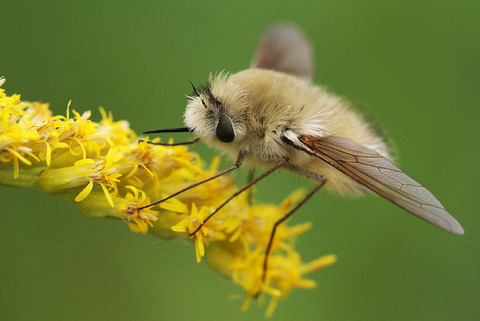
(Anastoechus nitidulus: AKA the author of this post)
#entomology#arachnophobia#spider#spiders#bug stuff#in which I talk about spooders#can you guys tell that i love spooders?#contains pictures#social spiders
22 notes
·
View notes
Text
I think I’ve talked a bit about this but I’m gonna go in-depth this time, about naming in my setting. This is gonna be long.
The main human culture of my setting (which has four subbranches, urban, settled rural, and nomadic, plus the halflings) uses personal names derived from the date of their adulthood ceremony, and then surnames from the date of their own or parents’ wedding ceremony. Nobles also take a middle name from the date of their accession to their title; full members of the initiation societies that teach things like magic, legally considered low nobility, likewise take a middle name from the date of their initiation. Finally, they may have a fourth name, not related to a date, that derives from an ancestor or a domain, and mainly designates larger kinship groups, like noble houses. (The three names are simple compounds, while the fourth name has the possessive prefix appropriate to the person or thing the name comes from—except in halfling, where the fourth name is in the genitive case of the appropriate noun-class for whatever the name comes from.)
The other three human cultures do things a bit differently. The witch empire (now surviving mainly as subterranean and aquatic mutants) takes its surnames from the name of a parent, in the genitive and prefixed by “child”. Then if they are themselves witches they take a “coven name” as a middle name, and noble houses have names derived from the coven name of an ancestor, in the plural genitive, prefixed by “house”, also in the genitive. (So they, too, have up to four names, personal and a patronymic derived from a personal, and then coven and a house name derived from a coven name.) The nomads descended from survivors of their empire’s fall just use the personal names and patronymics, not having retained their ancestors’ witchery. The empire on the other side of the planet takes its surnames from the 161 administrative divisions of their empire (that might seem like too few surnames but the Han Chinese are traditionally said to have only 100—and 54% of Koreans, who use Chinese-derived names, have one of five of them). And the “barbarians” who trouble that empire just use “son/daughter of parent” as a surname, and sometimes also the name of one of the spider-people that enslaved them or their ancestors.
Married dwarves have a middle name that’s just their spouse’s name in the volitional genitive case (for things whose acquisition the possessor controlled) if married, and then their surname is their clan name; they have something like 94 clans. (Formally they have a second middle name that’s the name of a parent in the non-volitional genitive, which is for things whose acquisition the possessor did not control. Clan names are also in the non-volitional genitive, but don’t derive from anything but themselves.)
Elves also have a gamonymic (“spouse name”) middle name, that’s their spouse’s name in the genitive-dative case (“oblique”, I want to say?), then “of” and the clan name of one parent, then “and” and the clan name of the other parent. Their clan names come from their sacred groves, and they have 242 of them.
Gnomes have one name given at birth, plus the names of both their parents with an instrumental prefix, and, if married, their spouse’s name with a benefactive prefix. They also have 144 surnames that don’t actually come from kinship (though all members of a household typically have the same one), but from one’s ritual community. Throughout their life, though, a gnome will add extra names, in the same format as the one given at birth, that reflect accomplishments. It’s quite likely for a gnome to be called a different name by each of their gnome acquaintances, so they tend to address people by kinship terms or profession, if they need to be clear.
Goblins use the name of their father or husband, in the oblique case, except married men, who don’t have surnames—the base unit of goblin society is an adult male and his wives and children. Except if a married goblin man is the vassal of another goblin, then he uses that goblin’s name in the oblique as a surname; the women and unmarried men of his household also append their husband or father’s liege’s name after the husband or father’s—in a large horde they can have very long names, since they include those of every goblin in the hierarchy. Ogres’ and orcs’ names are similar, though they use the volitional genitive particle for husbands and the non-volitional for fathers, and don’t bother about lieges’ names, ogre allegiance being a temporary thing. Kobolds have the same kinds of names as gnomes, but in a totally different language.
Dragons don’t have surnames, but they use honorifics made by combining their age-category with their elemental affinity (“fire hatchling, ice elder”, etc.).
Giants use patronymics and matronymics, both at the same time. Cat, hyena, and yak people (who started speaking Giantish after they escaped the witch empire that created them) use the same sorts of names, but cat people use matronynics only (they’re not as promiscuous as cats but the cat half of their blood still inclines them to less than stable pairings). Yak people attach different importance to the two names, with the patronymic functioning more like a clan name since they’re polygamous. You might think the hyena people should put more focus on matronymics, but only spotted hyenas are matriarchal, not striped or brown—or giant short-faced (which lived like striped), and that’s what the hyena people were hybridized with.
Finally, I haven’t figured out whether snake and spider people have true surnames or just use parents’ names, but I do know that either way they’re matrilineal, since maternal care is much more common in both than two-parent. Likewise the ant- and bee-people who serve the spider people are matrilineal, being almost entirely female; think they just use matronyms, since their whole colonies have the same mother. (If there were termite people they’d be different, since their colonies don’t work like Hymenoptera ones.) But the lizard people have bilateral kinship, since they use the monogamous social structure found in skinks. The snake people are also monogamous (pair-bonds being observed in cottonmouths, copperheads, and possibly rattlesnakes, and being the only true social arrangement related to mating, in snakes—a “mating ball” isn’t really social). The spider people are polyandrous, but think, like, tarantulas, not black widows.
2 notes
·
View notes
Text
After thinking upon it a fair bit, I don’t think you really can compare the Diamonds to real world political systems, either as a literal Gem governance, or as allegory/applicability.
People in that position choose to do horrible things because they profit off it, or they don’t care enough to consider other people as human. But the Diamonds aren’t like that; they’re not human, with a human’s sense of short-term gain.
The Gems aren’t human. This should be obvious. It’s just that with the Diamonds, we see the potentially destructive aspect of that. They do not think like humans. Gems are collectivist beings that define themselves entirely by their function and purpose, with even the Crystal Gems redefining that purpose, and the Homeworld Gems on Earth need to keep doing something that keeps to their original job. The few who go entirely outside that framework can be thought as neurodivergent, from a Gem POV.
The Diamonds do not rule, exactly. They direct, perhaps, but mostly they are producers, generating the substances required to create new Gems. Other gems cannot be born without the Diamonds; they’re called matriarchs for a reason. Their only thoughts are for Gemkind’s long term survival, thought out in thousands of years at a time, and it doesn’t resemble any political system at all. They simply... exist, and their purpose in Gem society may be an outgrowth of that function.
You’re not thinking of a fascist leader. You’re not thinking of a tyrant. The closest analogue to what the Diamonds are is a bee’s hive queen, or perhaps the queen of an ant hill; the primary producer unit of a eusocial collective organism, that survives by consuming everything around it.
Because it doesn’t know better.
The Gems, and the Diamonds, do what they do because it’s how they survive, as a species. Is it cruel? Yes. Is it destructive and a cycle of destruction to all other forms of life? Again, yes.
But it’s not much different from, say, what an ichneumon wasp does. Is their parastiic life style awful? Oh yeah, you wouldn’t want one capable of doing what to you. But it’s not evil, for the wasp, because it’s an animal. It doesn’t know better; it CAN’T know better.
And until Rose Quartz, and her son Steven, the Gems were in the same situation. They were incapable of understanding the evil they were doing for their own survival, until Rose came around and grew out of that, and her Gem followers did the same. (They don’t particularly LIKE humans, but they acknowledge them as living beings.) And Rose created Steven, who was able to force the Diamonds to understand the horrors they’d wrought, and put a stop to it.
So, with the shift in the Diamond’s character development, we’re sort of seeing in the Diamonds the same character development that must have happened for the Crystal Gems; the gradual shift in viewing non-Gem life as ‘resource’ to ‘person’ and the severe adjustment to perspective that demands. After all, they’d lived for eons as the intergalactic equivalent of those ants that march and eat everything in their way; the personal shift for them has to be... big.
#su#analysis#sometimes an alien perspective is a very dangerous thing#as exemplified by the Diamonds#granted on top of their inhuman perspectives#they're also rather unpleasant for the most part until Steven sort of#encourages them to be better people
6 notes
·
View notes
Text
Mr. Tesla Explains Why He Will Never Marry

Famous Scientist Felt Unworthy of Woman as She Used To Be, and Now He Can't Endure Her Trying to Outdo the Men
Galveston Daily News, Galveston, Texas, page 23. August 10, 1924.
"I had always thought of woman as possessing those delicate qualities of mind and soul that made her in these respects far superior to man. I had put her on a lofty pedestal, figuratively speaking, and ranked her in certain important attributes considerably higher than man. I worshiped at the feet of the creature I had raised to this height, and, like every true worshiper, I felt myself unworthy of the object of my worship.
"But all this was in the past. Now the soft-voiced gentle woman of my reverent worship has all but vanished. In her place has come the woman who thinks that her chief success in life lies in making herself as much as possible like man--in dress, voice and actions, in sports and achievements of every kind.
"Women are becoming stronger than men, both physically and mentally.
"The world has experienced many tragedies, but to my mind the greatest tragedy of all is the present economic condition wherein women strive against men, and in many cases actually succeed in usurping their places in the professions and in industry. This growing tendency of women to overshadow the masculine is a sign of a deteriorating civilization.
"Woman's determined competition with man in the business world is breaking down some of the best traditions--things which have proved the moving factors in the world's slow but substantial progress.
"Practically all the great achievements of man until now have been inspired by his love and devotion to woman. Man has aspired to great things because some woman believed in him, because he wished to command her admiration and respect. For these reasons he has fought for her and risked his life and his all for her time and time again.
"Perhaps the male in human society is useless. I am frank to admit that I don't know. If women are beginning to feel this way about it--and there is striking evidence at hand that they do--then we are entering upon the cruelest period of the world's history.
"Our civilization will sink to a state like that which is found among the bees, ants and other insects--a state wherein the male is ruthlessly killed off. In this matriarchal empire which will be established the female rules. As the female predominates, the males are at her mercy. The male is considered important only as a factor in the general scheme of the continuity of life.
"The tendency of women to push aside man, supplanting the old spirit of cooperation with him in all the affairs of life, is very disappointing to me.
"Woman's independence and her cleverness in obtaining what she wants in the business world is breaking down man's spirit of independence. The old fire he once experienced at being able to achieve something that would compel and hold a woman's devotion is turning to ashes.
"Women don't seem to want that sort of thing to-day. They appear to want to control and govern. They want man to look up to them, instead of their looking up to him."
"I am considering this question not merely from the standpoint of a man," he points out. "I am thinking of the woman's side of it.
"As we contemplate any change, we naturally take into consideration the results that may follow such an innovation. One of the results to my mind is quite a pathetic one. Woman, herself, is really the victim instead of, as she thinks, the victor. Contentment is absent from her life. She is ambitious, often far beyond her natural equipment, to attain the thing she wants. She too frequently forgets that all women cannot be prima donnas and motion picture stars.
"Woman's discontent makes the life of the present day still more overstressed. The high pitch given to existence by people who are restless and dissatisfied because they fail to achieve things wholly out of proportion to the health and talent with which Nature has endowed them is a bad thing for the world.
"It seems to me that women are not particularly happy in this newly found freedom, in this new competition which they are waging so persistently against men in business and the professions and even in sport. The question that naturally arises is, whether the women themselves are the gainers or the losers.
"Discontent makes for cranks and unnatural people. There seems to be an uncommon number of them about today. This is one of the reasons I remain apart from the crowds. The public, or semi-public, character is the target for all sorts of attacks and unpleasant communications.
"For example, I used to receive all sorts of strange notes, many of them letters from cranks threatening my life, because they had read about my experiments in manufacturing lightning bolts. They wrote that they believed I was using these lightning flashes to kill them!
"It seems to me that anything which adds to the great discontent which we observe on every side to-day must be a bad influence on our life. Women who keep themselves agitated by their tremendous ambition to beat man at his game are losing at the same time something that counts for more in the end, it seems to me, than the empty honors that success in business or one of the professions can ever give.
"The power of the true woman is so great that I believe if a beautiful woman--that is to say, one beautiful in spirit, in manner and in thought, in fact, beautiful in every respect, a sort of goddess--were to appear suddenly on earth, she could command the whole world. Her leadership, I believe, would be universally recognized.
"History has given us many examples of the wonderful influence exerted by unusual women. Among these have been the mothers of great men. But their influence lay not in their determination to outdo man, or even to compete with him.
"Perhaps because woman is a finer and more highly sensitized instrument she knows by instinct her power and understands that the extent of it lies in the high position she takes for herself. But the superior never descends to the level of the commonplace."
#nikola tesla#quotes#science#history#sociology#woman#women#feminism#equality#ahead of his time#ahead of our time
417 notes
·
View notes
Note
Do you think men are biologically sexist?
Short answer: yes and no.
Long, likely rambling answer: global history tells us men have always oppressed women. Observations of other species show us other males that are equally as terrible to the females of their species. That strongly indicates a biological component.
What, though? We know it’s not brain sex. There are more differences between individual brains than between women and men. Yet men commit the vast majority of violent crime all around the world throughout human history.
So perhaps something in our physical differences affects male brain development. Which ones, though? Well, men have penises and women don’t. That might be part of it, that possessing a penetrative sexual organ inherently conditions one to feel entitled to and behave aggressively towards females. Certainly the males of other species that have penises use them in the same terrible ways that human males do.
Another part of it may be the inability of males (barring seahorses) to become pregnant. There is a biological drive to reproduce. A female of a species that gestates young always knows her offspring is hers. A male doesn’t, so the males of many species tackle that “issue” in various ways. Duck penises have a broom at the end of it to sweep away other duck sperm. Male bears will kill all cubs on site because the chance they’re his aren’t high and then he can mate with the female. Male lions have an entire pride of lionesses and a new male moving in will kill any existing cubs. Men try to keep their girlfriends or wives from speaking to any other men. Control a woman and her reproductive choices and you control whether you reproduce or not.
But there’s a problem here. Not every species gestates their young. Most fish, for example, simply release eggs into the water that are fertilized with sperm. And yet, the male fish of many of these species are still very aggressive towards the females. These fish don’t have penises either. And neither does the male Rhinella proboscidea frog, who often kills the female during reproduction. Though that is the only example of reproductive necrophilia, there are plenty of other animals that engage in other forms.
So it’s not just penises and it’s not just womb envy. What, then? Superior strength? That’s pretty variable. In many species the female is much bigger and stronger than the male. So what is it? Well, the only thing the males of all species have in common is sperm production. But what about sperm production could cause or contribute to awful behaviour towards females? I honestly don’t know, and I doubt any scientists are looking into it. We may never know. But the fact is males are terrible to females and men are no exception.
Yet “sexism” implies male supremacy, as in men believing they are superior to women, and that belief itself does not appear to be inherent. Elephants and hyenas are matriarchal. Wolf packs are sometimes led by a female. There was a baboon tribe where all the aggressive males died that then became matriarchal and any new male baboons had to behave pleasantly or be forced out. In ant and bee colonies, the “workers” and “warriors” are all female. The lionesses of a pride most often do the hunting.
The notion that females are less important or capable than males, or shouldn’t be allowed to do certain things doesn’t seem to exist in most, if any, other species. Perhaps, as humans came to our full consciousness, sexism was what men needed both to justify to themselves their treatment of us, and to keep us from fighting back.
So yes, sexism is biological in the sense that the tendency to harm females is not at all limited to human males. No, in the sense that male supremacy does seem to be an entirely human invention. I think that sexism on this large a scale (if it was just a few pockets or in a relatively short time period, that would be different) could not exist without the biological component, whatever it may be, that fuels males’ urge to harm females. But that biological component doesn’t need sexism in order to exist.
Socialization, however, will ensure they are in a never-ending loop with each other. Biological urge to hurt women inspires sexism, which justifies hurting and controlling women, whose defensive actions are then touted as examples of female inferiority, which of course is sexism, which justifies men’s violent behaviour, etc..
33 notes
·
View notes
Text
WBJ 2017: Hierarchy, Power, & Governance
In Phandalin, the town is run by a mayor. The players may meet the mayor, depending on how they play and where they want to go. The mayor makes sure the town runs smoothly and that they trade with the surrounding towns. The mayor is a middle-aged human woman named Bridget, who lives with her partners a dwarf man named Gimli and a enby dragonborn named Cyril. The mayor has 10 years in the position until a new one can be elected. The mayor is allowed to step down at any time during their 10 year term, and a new one will be elected by popular vote.
On the rocks’ moon (this place needs a name, I will come up with on eventually, maybe in game cause I’m playing Saturday), the rocks used to be “led” by a black and white speckled rock. However, right now the leader of the rock people is a rock that is gray but has a black splotch on the top of it in the shape of a star. The rock isn’t the biggest one, but it has been around the longest (after the leader before, a white and black speckled one, was murdered). The leader rock tries to make sure the tensions between the different colors don’t get out of hand and that new rocks have places to live underground. The new rock leader after this one will be the next one that has been alive the longest after that. Its by age. (NOTE: there is a disease that can kill the rocks, and cause them to erode and eventually die prematurely, they are terrified of this disease. To the adventurers it looks like some type of plant or moss that slowly splits the rocks apart. This will be related to the plant people from the 5th portal).
In the merpeople kingdom, there is a royal family. The society is a matriarchal one, so the new leader will always be the oldest female child of the Queen. The queen doesn’t have to marry within the royal class, and can marry whoever they choose. Sometimes it will be another royal but from another kingdom (helps with ties) but doesn’t have to be. If a Queen is incapable of producing and heir, they are allowed to adopt a child who will become the Queen. This system isn’t overthrown when the new heir, Brielle, comes out as a trans mermaid, but some merpeople do not like the idea at all. There are other kingdoms that people can live in, but these towns developed by way of people populating this particular area for resources and more and more people kept coming so the town grew around this. Each kingdom has something its known for, and these items can get exported, while they import other goods. There’s a small force of militia of merpeople that are part shark and octopus, and maybe some other fish predators.
The ghost town used to be run by a mayor as well. The dead mayor is still in charge of all of the dead spirits that have stuck around. The mayor is probably possessing something significant in town. The dinosaurs don’t really have a hierarchy unless you count the talking t-rex as the leader simply because they’re the biggest.
The bats don’t have a leader, they simply follow their animal instincts. The golems do have a leader, a huge lava golem called Craig. The rock golem, Heath, that contains the artifact is Craig’s partner, and the only golem that can speak (bc of the artifact). If Craig is killed, its super difficult to get the artifact away from Heath.
The bugs mainly act like ants, with colonies of their own particular species. There are a lot of different species on this planet, but not as many as on earth. Just a few different ones: bees/wasps, butterflies, moths, spiders, grasshoppers/crickets, praying mantis. Depending on the species, they either have one ruler or they’re nomadic with no true leader, or egalitarian. The plant people on the other hand have a full blown government, with a cabinet of leaders. One person is elected from various species and they all vote on important things, like trade, or new buildings, etc.
Instead of having a mayor that is elected, someone else from town overthrew the mayor and while Brigit wasn’t killed, Gimli was. Brigit and Cyril are mourning when the adventurers come in. Everything else is run the same for the most part. The mayor is corrupt and drains ppl’s money from them. They don’t let things get imported or exported and the town is suffering.
This is the first time I’ve talked about it, but the companions will have a companion controlled by me that helps them on their quests, as in leading them to the portal place where all the portals are and tells them the legends of the artifacts and how they must stop the big baddie. They maintain their control thru knowledge that the companions do not have. There may also be a set of twins that I control, but I haven’t fleshed them out yet.
Previous Post: Economy
Next Post: Religion/Cosmology & Traditions/Holidays
1 note
·
View note